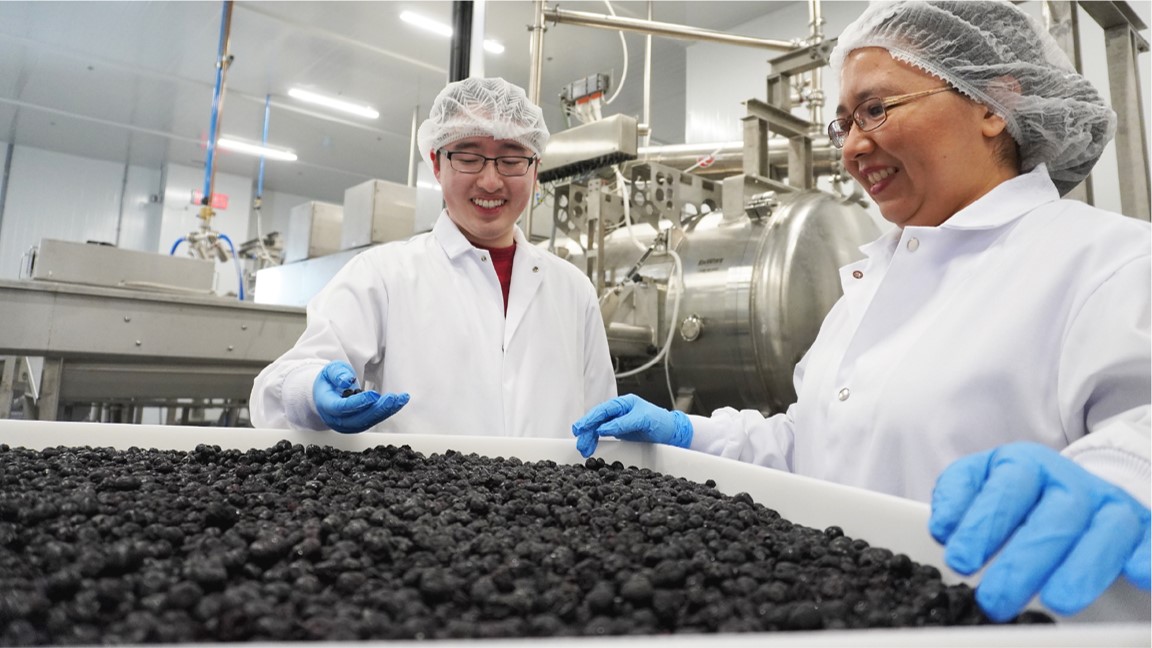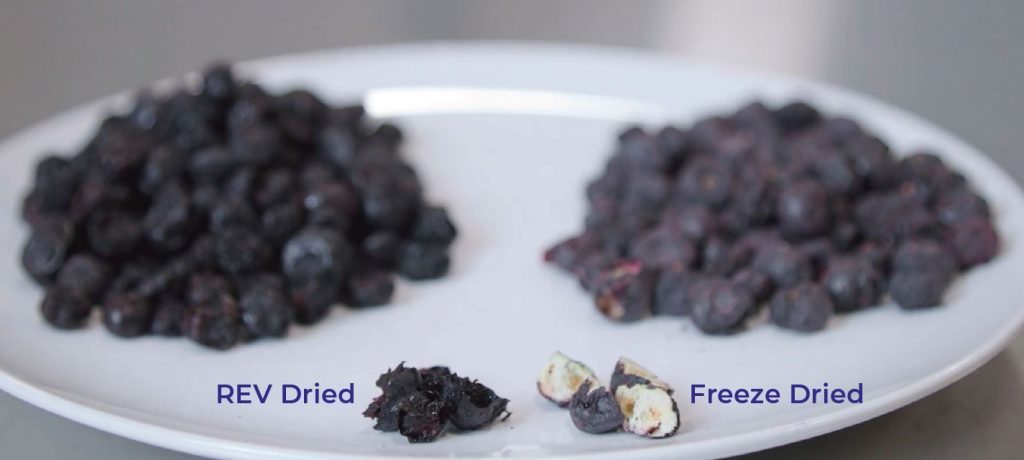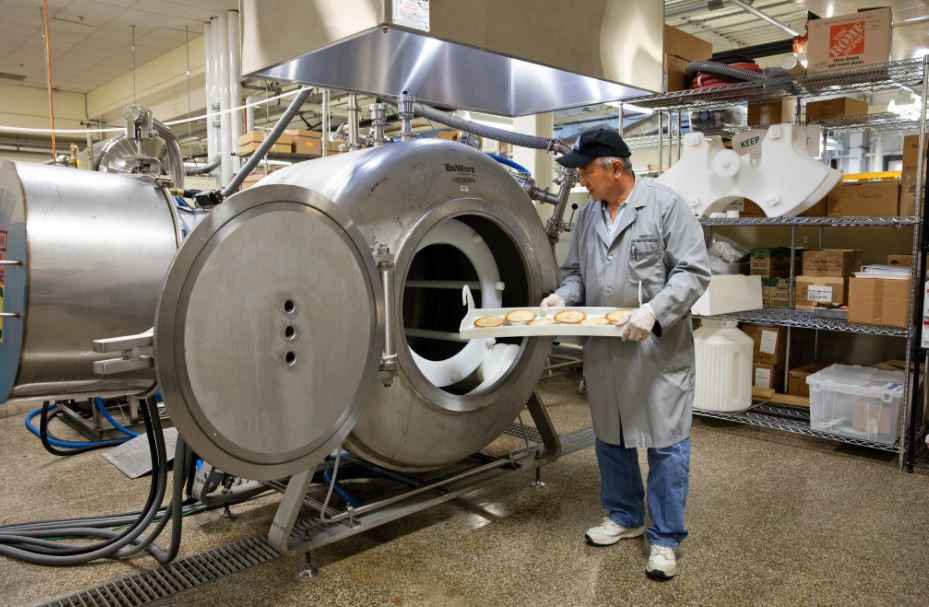Gefriertrocknung vs. Mikrowellentrocknung
In the world of food preservation and processing, two innovative drying methods have gained significant attention: freeze drying and microwave drying. As businesses seek more efficient and effective ways to preserve products while maintaining quality, understanding the differences between these techniques is crucial. In this blog, we’ll explore the key aspects of freeze drying and microwave drying, comparing their processes, benefits, and applications.
Understanding Freeze Drying
Freeze drying, also known as lyophilization, is a dehydration process that removes water from frozen products through sublimation. This method involves three main steps:
- Freezing: The product is frozen to temperatures below its triple point.
- Primary drying: The frozen water is removed through sublimation under vacuum conditions.
- Secondary drying: Any remaining unfrozen water molecules are removed through desorption.
Freeze drying is known for its ability to preserve the structure and nutritional content of food products. It’s particularly useful for drying heat-sensitive materials, as the low temperatures and absence of liquid water minimize degradation.
Exploring Microwave Drying
Microwave drying, on the other hand, uses electromagnetic waves to heat and remove moisture from products. EnWave’s Radiant Energy Vacuum (REV™) technology is a prime example of this innovative approach. The process typically involves:
- Creating a vacuum environment
- Applying microwave energy to the product
- Rapid, uniform heating and moisture removal
This method offers several advantages, including faster drying times, energy efficiency, and the ability to preserve product quality.
Key Differences and Comparisons
Processing Time
One of the most significant differences between freeze drying and microwave drying is the processing time. Traditional freeze drying can be a lengthy process, often taking days to complete. In contrast, microwave drying, particularly when combined with vacuum technology, can dramatically reduce drying times.
EnWave’s REV™ technology, for instance, can achieve drying times as short as 30 minutes for some products. This significant reduction in processing time can lead to increased productivity and reduced operational costs for manufacturers.
Energy Efficiency
Energy consumption is a crucial factor in food processing. Freeze drying, while effective, is known for its high energy requirements. A study comparing different drying technologies found that freeze drying consumed 15.09 kWh of energy, while microwave vacuum drying used only 1.27 kWh – just 8.42% of the energy required for freeze drying.
This substantial difference in energy consumption makes microwave drying, especially when combined with vacuum technology, a more sustainable and cost-effective option for many applications.
Product Quality
Both freeze drying and microwave drying are capable of producing high-quality dried products. However, there are some notable differences:
Appearance
Microwave vacuum drying often results in better color retention compared to freeze drying. For example, strawberries dried using microwave vacuum technology maintain a vibrant red color, while freeze-dried strawberries tend to have a duller, bleached appearance.
Texture
Freeze-dried products often have a spongy texture, while microwave-dried products can achieve a range of textures from crunchy to chewy, depending on the specific process parameters.
Nutrient Retention
Both methods are effective at preserving nutrients, vitamins, and antioxidants due to their relatively low processing temperatures and oxygen-free environments.
Aroma Compounds
A study comparing different drying methods found that freeze drying preserved the most aroma compounds in hops, followed closely by microwave vacuum drying.
See the difference yourself!
Moisture Content
The final moisture content of dried products can vary between the two methods. Freeze drying typically achieves moisture levels between 1-4%, while microwave vacuum drying can achieve a wider range of moisture levels, from 0.01% to 40%, depending on the specific product requirements.
Scalability and Cost
Freeze drying often requires significant capital investment and has high operating costs, partly due to the long processing times. This can make it challenging to scale up operations, especially for small to medium-sized producers.
Microwave drying technology, such as EnWave’s REV™, offers more flexibility in terms of scalability. The company’s partnership model allows businesses to start with smaller machines and scale up as demand grows, making it a more accessible option for a wider range of producers.
Applications and Industry Adoption
Both freeze drying and microwave drying have found applications across various industries:
- Food Industry: Both methods are used for drying fruits, vegetables, and other food products. Microwave drying is particularly well-suited for creating crunchy fruit snacks and preserving heat-sensitive ingredients.
- Pharmaceutical Industry: Freeze drying has been a staple in pharmaceutical processing, particularly for preserving vaccines and biologics. However, microwave-assisted freeze drying is gaining attention for its potential to reduce processing times and improve energy efficiency in this sector.
- Nutraceuticals and Functional Foods: The ability of both methods to preserve nutrients makes them valuable for producing high-quality supplements and functional food ingredients.
Future Trends and Innovations
The field of drying technology continues to evolve, with ongoing research and development focused on improving efficiency and product quality. Some notable trends include:
Microwave-Assisted Freeze Drying (MAFD)
This hybrid approach combines the benefits of both methods, potentially offering faster drying times while maintaining the quality advantages of freeze drying.
Energy Optimization
Researchers are exploring ways to further reduce energy consumption in both freeze drying and microwave drying processes.
Application-Specific Solutions
As industries become more specialized, drying technologies are being tailored to meet specific product requirements, such as the development of microwave-freeze drying systems for pharmaceutical applications.
The EnWave Advantage
While both freeze drying and microwave drying offer unique benefits, EnWave’s REV™ technology stands out for its ability to combine the advantages of microwave and vacuum drying. This innovative approach offers:
- Significantly reduced drying times
- Improved energy efficiency
- Excellent product quality retention
- Flexibility in final product moisture content
- Scalability to meet various production needs
For businesses looking to optimize their drying processes, improve product quality, and reduce operational costs, EnWave’s microwave vacuum drying technology presents a compelling solution.
Ready to explore how REV™ technology can transform your production process? Contact EnWave today for a consultation and discover the potential of advanced microwave drying for your products.




